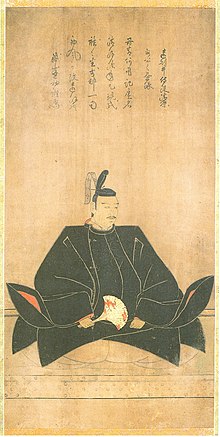Ii Naomasa
| Ii Naomasa | |
|---|---|
 |
|
| Lord of Takasaki | |
|
In office 1590–1600 |
|
| Preceded by | none |
| Succeeded by | Sakai Ietsugu |
| Lord of Hikone | |
|
In office 1600–1602 |
|
| Preceded by | none |
| Succeeded by | Ii Naokatsu |
| Personal details | |
| Born |
March 4, 1561 Tōtōmi Province, Japan |
| Died | March 24, 1602 (aged 41) Edo, Japan |
| Nationality | Japanese |
Ii Naomasa (井伊 直政?, March 4, 1561 – March 24, 1602) was a general under the Sengoku period Daimyo, and later Shogun, Tokugawa Ieyasu. He is regarded as one of the Four Guardians of the Tokugawa along with Honda Tadakatsu, Sakakibara Yasumasa and Sakai Tadatsugu.
Ii Naomasa was born in Hōda Village of Tōtōmi Province. His family, like the Tokugawa, had originally been retainers of the Imagawa clan, but following the death of the clan's leader, Imagawa Yoshimoto, in the Battle of Okehazama (1560), confusion and general chaos ensued. Naomasa's father, Naochika, was falsely convicted of treason by Yoshimoto's paranoid successor, Imagawa Ujizane, and was subsequently killed. Naomasa, then a very small child, was personally lucky to escape his father's fate and was later taken in by Tokugawa Ieyasu, who discovered Naomasa while hunting in Hamamatsu.
Ii Naomasa joined the ranks of the Tokugawa clan in the mid-1570s, rising swiftly through the ranks to eventually become the master of a sizable holding in Ōmi Province, following the Battle of Sekigahara (1600). His court title was Hyōbu-dayū.
Naomasa initially garnered mass attention at the Battle of Nagakute (1584), commanding around three thousand musketeers with distinction and defeating the forces led by Ikeda Tsuneoki. In the battle, Naomasa fought so valiantly that it elicited praise from Toyotomi Hideyoshi, who was on the opposing side. Following the battle, Hideyoshi's mother was sent to stay with Naomasa in genteel captivity, cementing an alliance between the Tokugawa and the Toyotomi. After Naomasa helped insure victory during the siege of Odawara (1590) by breaching the castle walls and contributing to the Hōjō clan's surrender, he was given Minowa Castle in Kōzuke and 120,000 koku, the largest amount of land owned by any of the Tokugawa retainers.
...
Wikipedia
